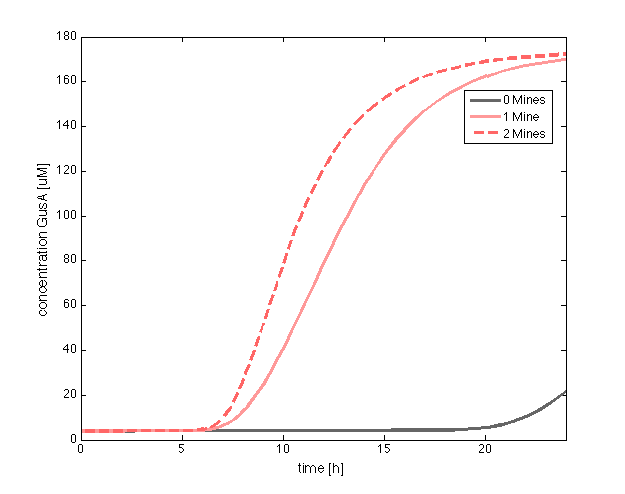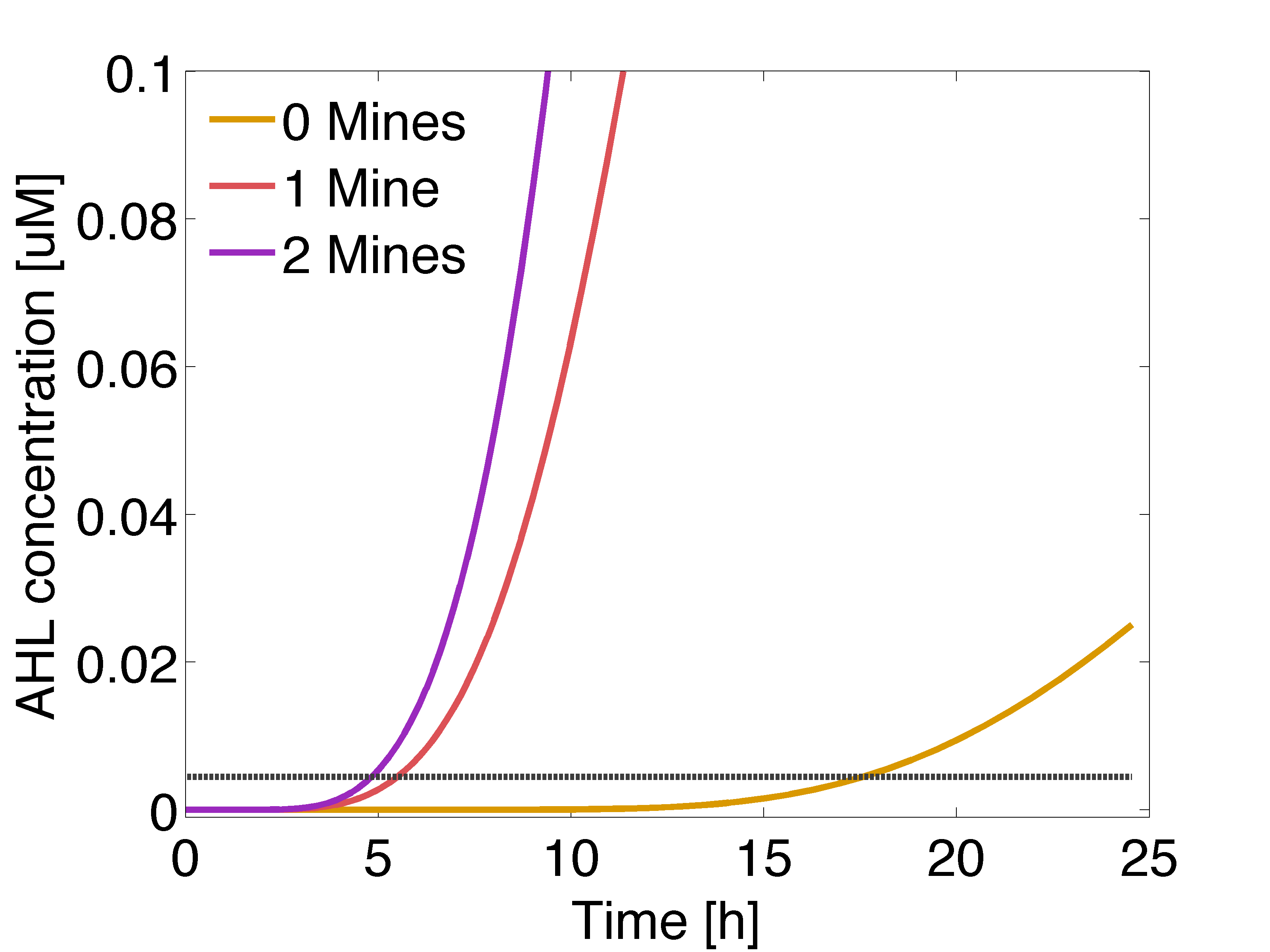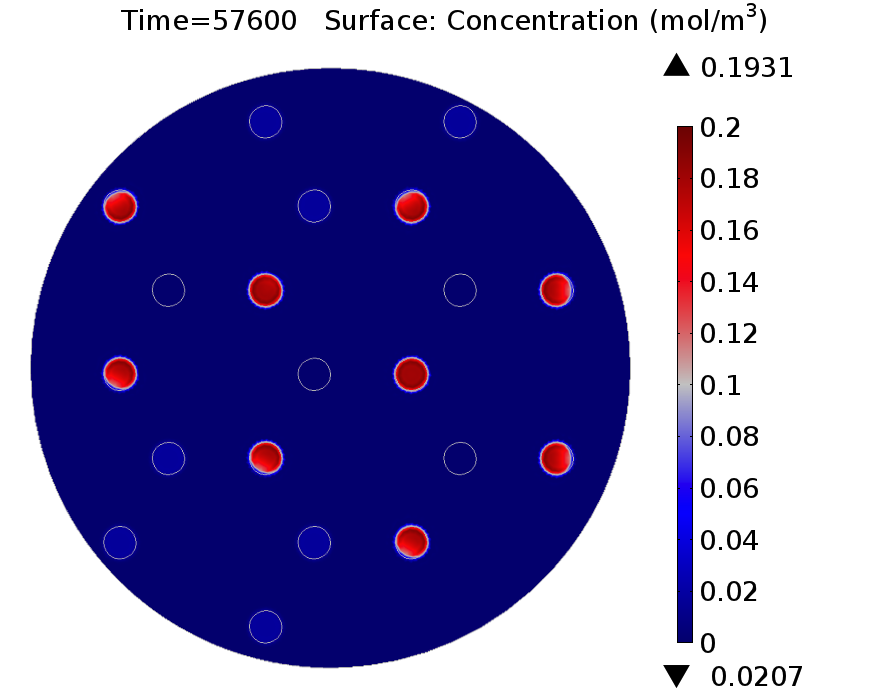Team:ETH Zurich/Modeling
From 2013.igem.org
| Line 18: | Line 18: | ||
<h1>Receiver Cells</h1> | <h1>Receiver Cells</h1> | ||
| - | <p align="justify">Receivers are engineered to respond differently to two OHHL concentration levels. Basically, cells should be capable of produce a visible response and in a reasonable amount of time | + | <p align="justify">Receivers are engineered to respond differently to two OHHL concentration levels. Basically, cells should be capable of produce a visible response and in a reasonable amount of time, because the player will need to discriminate between the presence of 0, 1 or 2 adjacent mines. To achieve this goal, we incorporate two enzymatic reporters acting as high-pass filters ([https://2013.igem.org/Team:ETH_Zurich/Experiments_4 ''GusA''] and [https://2013.igem.org/Team:ETH_Zurich/Experiments_4 ''AES'']). The expression of these enzymes is under the control of ''pLux'' promoters with different sensitivities, the wild type and a promoter mutant ([https://2013.igem.org/Team:ETH_Zurich/Experiments_5 G1 mutant]); The affinity constants for the promoters were obtained from our [https://2013.igem.org/Team:ETH_Zurich/Experiments_5 experimental data]. An importan feature of these enzymes is that they can catalyze the hydrolysis of various chromogenic compounds to give rise to a relatively quick coloured response. </p> |
| + | |||
The intracellular species of interest in the receiver cells module include: LuxR, OHHL, LuxR/OHHL complex (denoted as R) and the hydrolases (GusA and AES). | The intracellular species of interest in the receiver cells module include: LuxR, OHHL, LuxR/OHHL complex (denoted as R) and the hydrolases (GusA and AES). | ||
| Line 28: | Line 29: | ||
<h1>Results</h1> | <h1>Results</h1> | ||
| - | <p align="justify"> | + | <p align="justify"> |
| + | In figure 1 and 3 are shown the results regarding GusA expression levels. From the time course plot (Fig 1.), it can be pointed out that the activation of the gene is consistent with the OHHL concentration that is predicted to reach a receiver colony. Additionally, one can say that the incubations of the plates should not be longer than 17 hours, otherwise receiver cells that are more that one cell away from a mine can start synthesizing the enzyme. </p> | ||
{|style="border: none;" align="center" | {|style="border: none;" align="center" | ||
Revision as of 15:29, 4 October 2013
Contents |
Circuit containing hydrolases
A seven-species model was implemented to model the spatio-temporal behaviour of our multicellular sender–receiver system. The model was based on partial differential equations with Hill functions that captured the activation of protein synthesis as a function of the concentration of the signalling molecule.
For the agar plate and mine cells modules, we use the system of equations and parameters set of the previous simulation.
Mine Cells
The PDEs for the states involved in the sender module are given below:
Agar Plate
The PDE for OHHL in the agar plate is given below:
Receiver Cells
Receivers are engineered to respond differently to two OHHL concentration levels. Basically, cells should be capable of produce a visible response and in a reasonable amount of time, because the player will need to discriminate between the presence of 0, 1 or 2 adjacent mines. To achieve this goal, we incorporate two enzymatic reporters acting as high-pass filters (GusA and AES). The expression of these enzymes is under the control of pLux promoters with different sensitivities, the wild type and a promoter mutant (G1 mutant); The affinity constants for the promoters were obtained from our experimental data. An importan feature of these enzymes is that they can catalyze the hydrolysis of various chromogenic compounds to give rise to a relatively quick coloured response.
The intracellular species of interest in the receiver cells module include: LuxR, OHHL, LuxR/OHHL complex (denoted as R) and the hydrolases (GusA and AES).
In addition to new proteins incorporated to the circuit, it is important to emphasize that the grid was changed to a three neighbours setup.
Results
In figure 1 and 3 are shown the results regarding GusA expression levels. From the time course plot (Fig 1.), it can be pointed out that the activation of the gene is consistent with the OHHL concentration that is predicted to reach a receiver colony. Additionally, one can say that the incubations of the plates should not be longer than 17 hours, otherwise receiver cells that are more that one cell away from a mine can start synthesizing the enzyme.
 "
"











